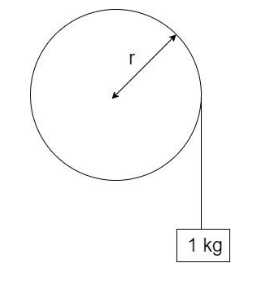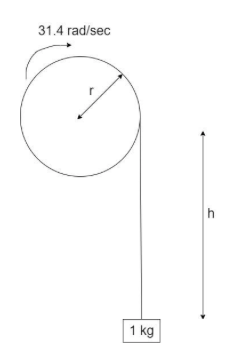
A wheel and axle having total moment of inertia of
Answer
484.2k+ views
Hint:When a mass is tied around the axle, it pulls down the cord thereby, rotating the axle. Here, the total energy of the system is conserved i.e. the gain in potential energy by the mass when it is pulled down is equal to the loss in kinetic energy of the rotating axle.
Complete step-by-step answer:
Consider a flywheel-axle setup with a weight of 1kg hanging downwards as shown:

Because of the weight acting, the block goes further downwards to a height of h, the rotational speed of flywheel is restricted to 31.4 radians per second, as shown:

Since the block moves to a height of h, it gains potential energy. This gain in potential energy is at the expense of the loss in kinetic energy of rotation of the flywheel, since the total energy of the system is always conserved.
Hence,
Gain in PE = Loss of KE
Gain in potential energy of the block =
Loss of kinetic energy is equal to the sum of kinetic energy due to linear velocity and kinetic energy due to inertial effect of the flywheel.
Kinetic energy due to linear velocity, v –
Kinetic energy due to inertia –
where I – inertia and
Loss of kinetic energy =
The linear velocity of rotation, v is the product of radius and the angular velocity.
Substituting, we get –
KE =
By conservation of energy, we have –
Given,
Mass of the block, m = 1 kg Radius, r = 1 cm = 0.01m Acceleration due to gravity,
Substituting these values,
Solving,
Therefore, the height of descent of the block is to be, h = 0.105 m
Note:One of the most common applications of flywheel is the areas where we need to smoothen out the power output of an energy source, that produces energy in pulses or regular intervals, such as internal combustion engines in the automobiles. Along with the function of smoothing out the power, the flywheel, additionally, acts as surge protector. This means that when the power output in the engine fluctuates suddenly, the jerk is not felt at the output because the flywheel absorbs the surge power and smooths it out.
Complete step-by-step answer:
Consider a flywheel-axle setup with a weight of 1kg hanging downwards as shown:

Because of the weight acting, the block goes further downwards to a height of h, the rotational speed of flywheel is restricted to 31.4 radians per second, as shown:

Since the block moves to a height of h, it gains potential energy. This gain in potential energy is at the expense of the loss in kinetic energy of rotation of the flywheel, since the total energy of the system is always conserved.
Hence,
Gain in PE = Loss of KE
Gain in potential energy of the block =
Loss of kinetic energy is equal to the sum of kinetic energy due to linear velocity and kinetic energy due to inertial effect of the flywheel.
Kinetic energy due to linear velocity, v –
Kinetic energy due to inertia –
where I – inertia and
Loss of kinetic energy =
The linear velocity of rotation, v is the product of radius and the angular velocity.
Substituting, we get –
KE =
By conservation of energy, we have –
Given,
Mass of the block, m = 1 kg Radius, r = 1 cm = 0.01m Acceleration due to gravity,
Substituting these values,
Solving,
Therefore, the height of descent of the block is to be, h = 0.105 m
Note:One of the most common applications of flywheel is the areas where we need to smoothen out the power output of an energy source, that produces energy in pulses or regular intervals, such as internal combustion engines in the automobiles. Along with the function of smoothing out the power, the flywheel, additionally, acts as surge protector. This means that when the power output in the engine fluctuates suddenly, the jerk is not felt at the output because the flywheel absorbs the surge power and smooths it out.
Recently Updated Pages
Master Class 11 Economics: Engaging Questions & Answers for Success

Master Class 11 Business Studies: Engaging Questions & Answers for Success

Master Class 11 Accountancy: Engaging Questions & Answers for Success

Master Class 11 English: Engaging Questions & Answers for Success

Master Class 11 Computer Science: Engaging Questions & Answers for Success

Master Class 11 Maths: Engaging Questions & Answers for Success

Trending doubts
How much is 23 kg in pounds class 11 chemistry CBSE

Difference between physical and chemical change class 11 chemistry CBSE

Number of oneone functions from A to B where nA 4 and class 11 maths CBSE

Whales are warmblooded animals which live in cold seas class 11 biology CBSE

How many squares are there in a chess board A 1296 class 11 maths CBSE

In the tropical evergreen forest one of the common class 11 social science CBSE




